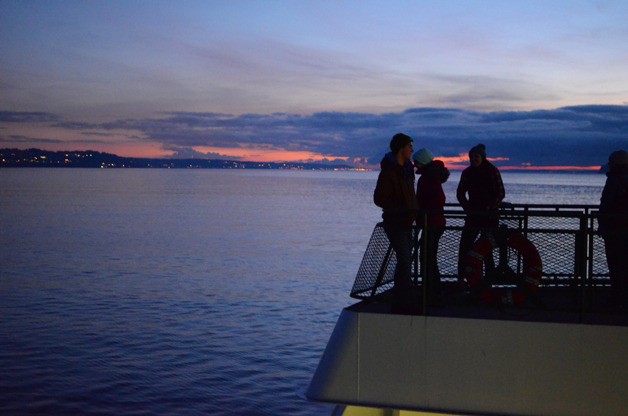Anyone hoping to catch a late-night ferry back to Whidbey Island in the future may be out of luck.
Washington State Department of Transportation’s 2015-2017 budget includes ferry service reductions to four routes, with the Clinton/Mukilteo route among them. Final sailings — 12:30 a.m. sailing from Clinton and 1:05 a.m. from Mukilteo — Monday through Friday during the fall, winter and spring schedules would be eliminated.
Whidbey’s Ferry Advisory Committee has been through similar service cut proposals before. Dave Hoogerwerf, a Clinton resident and longtime member of the committee, said he was unpleasantly unsurprised by the inclusion of Clinton for sailing reductions.
“Unfortunately they seem to want to do this every time they form a new budget … I’m not happy about it,” he said, adding that he was preparing a letter to Whidbey legislators advocating against the change.
“That’s where the action gets taken,” Hoogerwerf added.
The service change would go into effect September 2015. According to transportation budget documents, the ferries division expects to lose 5,320 riders in 2016 and 2017. By cutting the Mukilteo and Clinton routes, however, the ferries division hopes to save nearly $970,000 over two years, with $910,000 of that coming from labor and benefits savings. Between all of the service changes, the department of transportation figures to save $2.1 million.
In a budget Decision Packages document, the ferries service reductions are justified because they fulfill its strategic investments goal “by balancing to available revenue and allowing other strategic investments to be made.” Ferries looked at increasing fares “significantly” or cutting other department activities, but cutting the final sailings from each ferry terminal was selected because it did not add to the fare or call for other transportation reductions. The state agency acknowledges that, “The reduction in ferry service, however, reduces — rather than improves — the value of the state’s transportation infrastructure.”
Hoogerwerf adamantly disagreed with the assertion that no other way to reduce expenses could be found within the transportation agency.
“The first thing they go to is service cuts. I don’t understand it,” he said. “They’re telling us that they’re so efficient, so lean that they have to go to service cuts, something that disrupts the users. I’ve been in business long enough to know that it can be done elsewhere.”
During the last biennium budget process for the transportation department, the Whidbey Ferry Advisory Committee surveyed the late-night sailings from Clinton. They wanted to hear from people who rode the ferry and counted cars to get a better idea of who was riding and why. Hoogerwerf said they learned that many were regular riders who worked late shifts, as noted by the DOT budget decision with the anecdotes of Boeing swing-shift employees working past normal hours and “mainland patrons traveling to evening events” being affected. They also discovered that not many cars packed the late sailings, “But the people who are on it absolutely need it,” Hoogerwerf said, and that some riders were healthcare workers who relied on the ferry to get home on the South End of Whidbey.
“Some of those people said that without that ferry they’d have to move off island,” Hoogerwerf said.
While Whidbey, unlike other routes being affected such as the San Juan Islands and Vashon Island, is connected by a bridge, Hoogerwerf and Jack Lynch, president of the Clinton Community Council, said that isn’t really an option for South Whidbey residents.
“What I’m not sure or clear about is how that affects workers,” Lynch said. “As far as us for recreational purposes, going into Seattle and such, means planning on when to go home.”



